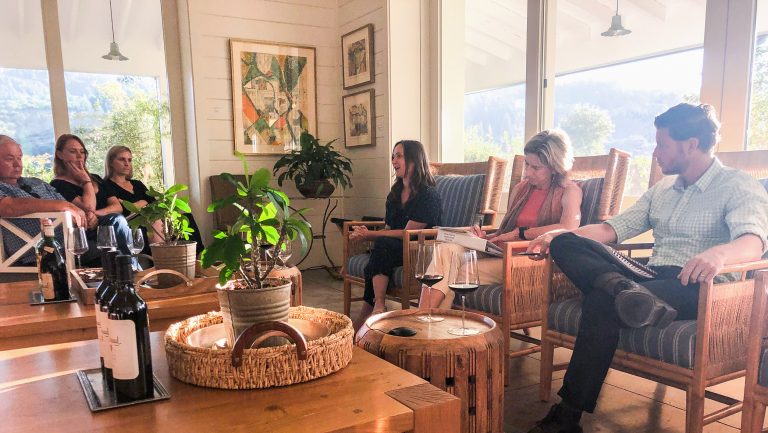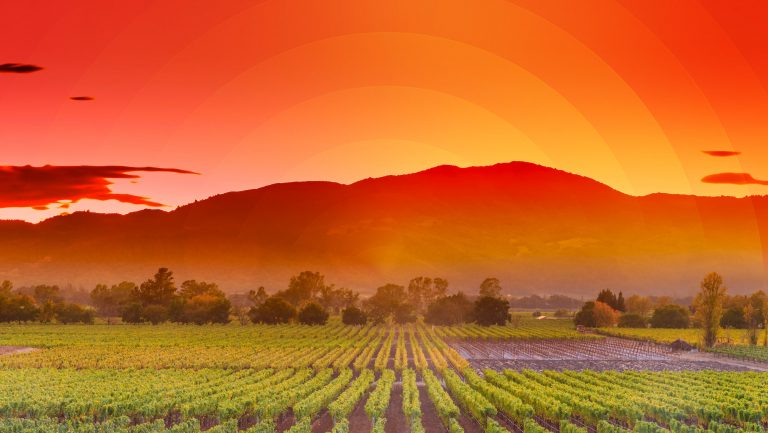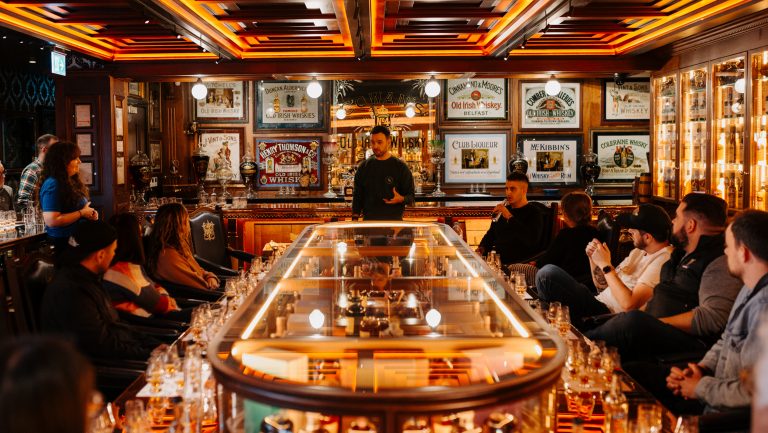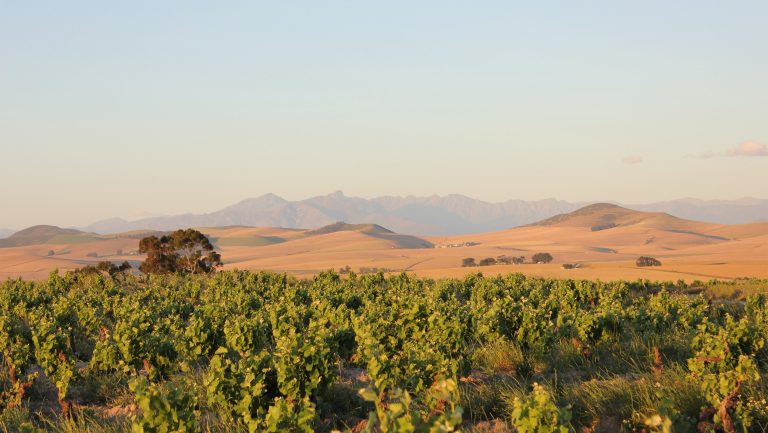This opinion piece is the second in a two-part series that addresses the need for a proactive response to climate change in California’s Napa Valley.
Last month, SevenFifty Daily published an essay I wrote entitled Why Napa Valley Needs to Start Talking About Climate Change, a topic on which I’m extremely passionate. In that article, I addressed four major areas of impact within the wine industry—water, temperature, workforce, and terroir—and in this follow-up story, I discuss what we can do to prepare for the changes that are coming and outline actionable next steps for adapting to climate change and preserving California’s Napa Valley for future generations.
How we adapt to these changes was also the topic of discussion at the Future of Cabernet: Climate Change, a salon session I hosted—quite fittingly on a 105-degree day—at Larkmead Vineyards in Calistoga, on Wednesday, August 14. The session highlighted important research and findings by producers who are leading the charge with sustainability efforts in Northern California’s wine industry. Moderated by Kelli White, a senior writer for GuildSomm and the author of Napa Valley, Then & Now, the salon’s panel featured Julien Gervreau, the vice president of sustainability for Jackson Family Wines in Santa Rosa, Beth Milliken, the president and CEO of Spottswoode Winery in St. Helena, and Molly Moran Williams, the industry and community relations director for the Napa Valley Grapegrowers in Napa.

Don’t miss the latest drinks industry news and insights. Sign up for our award-winning newsletters and get insider intel, resources, and trends delivered to your inbox every week.
These individuals and the businesses they represent are leading the industry in preparation for climate change. They’re the people I’m personally motivated by, and in choosing them to participate in the salon, I wanted to present three distinct viewpoints within the wine industry: Jackson Family Wines represents a large corporation that’s operating on a global level. In my opinion, they are the preeminent leaders in sustainability, climate research, and action in the domestic wine industry. Spottswoode, the first Napa Valley winery to farm organically and the second to be certified, represents a small, family-owned, generational business. The Napa Valley Grapegrowers represents a support agency—it offers help and resources to Napa Valley farmers who are concerned about growing high-quality grapes in a sustainable manner. If you are overwhelmed by the science and what to do about it, or where to start, the Grape Growers association can tell you who to talk to and connect you with others who are working to enact change.
Measure Before You Manage
During the salon, Gervreau referred to the old adage, “You can’t manage if you don’t measure,” and it’s a perfect fit for this conversation. Before you do anything, I urge you to take the time to examine and understand your winery’s greenhouse gas (GHG) emissions. Once you know what’s contributing to your carbon footprint, you can start fine-tuning your actions to lower, or offset, your winery’s impact. A great place to start, Gervreau said, is with the EPA’s simplified GHG calculator.
This detailed process of examining your winery’s GHG emissions involves measuring the ins and outs of every single resource—for example, how many gallons of water it takes to produce one gallon of wine. “It really helps you get an understanding of where your hot spots are and where your areas of impact are,” said Gervreau, who also suggested assigning a value to each resource. “We started building on that baseline,” he said, “and actually assigned hard costs. Unless you can really understand the value of it, it makes it really difficult to justify saving it.”
Spottswoode has started this process, and we’ve gone through it at Larkmead as well. We’re now taking the data and strategically applying it to initiatives like tilling, cover cropping, and water use. We’re eliminating as much plastic as we can in the winery and vineyard. We’re doing the little things, but now we have to take the little things up a notch, go one step further, and create a culture within the winery that wholly supports sustainability.

Set Goals
I know it sounds cliché, but once you know what you’re dealing with, the first step in creating meaningful change is to set goals. In 2015, said Gervreau, Jackson Family Wines set 10 sustainability goals and targets to achieve by 2020 as a way to “really align with where we wanted to go as a business. Once you have goals, you can start aligning various initiatives toward achieving those goals.”
As of today, Jackson Family Wines has reached eight of the goals. One was to reduce GHG intensity per bottle of wine produced by 25 percent, which they’ve successfully done and then some, having brought the intensity down 39 percent. Another target was to reduce water intensity in the winery by 33 percent; it was down 36 percent by the end of 2018 thanks to a number of initiatives, like rainwater capture and storage—and the use of captured rainwater in non potable ways, such as for cooling towers. The company is also close to reaching a renewable energy goal: being 50 percent powered by on-site solar at its wineries by 2020 (electricity is one of the main sources of GHG emissions in the world).
“There’s a very clear mandate that a transition to a renewable energy economy is critical if we’re going to meet our climate goals as a society, and it also happens to be a very cost-effective opportunity,” said Gervreau. Between 2009 and 2014, Jackson Family Wines’ energy-efficiency efforts saved the company $8 million, which was then reinvested into its on-site renewable program, according to Gervreau. “I’m a big believer that there is a road map,” he said. “This is not rocket science, and it’s all about planning priorities of where we need to go as a society and as an industry.”

Experiment
Cabernet Sauvignon has been a very popular grape variety for more than 170 years. But when does that change? Can it last forever? We used to ride horses; now we drive cars. There are so many evolutions over time, and variable yields and variable quality caused by climate change will make Cabernet become much more expensive than it already is, and therefore I believe sustainability for our industry will rely on adaptation and evolution, and if that means Cabernet is no longer the most important variety planted in the Napa Valley, then I will be prepared for that.
At Larkmead, we’ve dedicated 2.5 percent of our vineyard land to create a research vineyard in an effort to get an idea of where Napa Valley can go once we hit the new climate paradigm. We’ve developed a 21-year program that’s broken down into seven-year increments (each phase will go all the way from fallow land to planting to testing the finished product with consumers). By 2035, when we anticipate that climate change will really start to impact Napa Valley Cabernet production, I will already have 15 years of research behind me.
For our first phase, we’re looking back to look forward. We’re planting half of the vineyard to heritage grape varieties that fell out of fashion in Napa Valley—Petite Sirah, Zinfandel, Chenin Blanc, and Charbono—which I believe will be suitable to Napa Valley’s new climate. We’ll plant the other half of the vineyard to grape varieties that share Cabernet-like qualities (dark, supple, and lush fruit with power and structure) and also thrive in warmer, Zone V climates in the Mediterranean and Southern Hemisphere. We chose grapes like Tempranillo, Portugal’s Touriga Nacional, and Syrah.
Spottswoode is doing similar research planting. Milliken said she’s experimenting with grapes such as Alicante Bouschet, Barbera, Mourvèdre, and Valdiguié (Napa Gamay). “I think Napa Valley is an incredible place for growing grapes,” said Milliken. “Right now, Cabernet does extremely well here. Longer term, hopefully, we can find other things and make adaptations so that making really fine wine continues to be viable. But it may not be Cabernet Sauvignon.”
Jackson Family Wines has dedicated two vineyard blocks to exploring different management techniques for maximizing soil health, such as tilling and spreading compost—or not tilling or spreading compost. “We’re going to see how those evolve over the course of the next five years,” said Gervreau, “while also looking at factors like, how difficult is it to farm? Do we see any qualitative or quantitative differences around yield, vine vigor, disease, or pest presence? We’re really trying to take a science-based approach.”

The Surprisingly Easy Change You Can Make
What’s the single largest emission source for a global wine company? Glass.
Most of the talk about mitigating climate change is focused on the vineyard, but one of the biggest and most immediate improvements you can make is actually within your supply chain—specifically, packaging. The industry often subscribes to the idea that better wine comes in heavier glass bottles, but glass is made by melting sand at 1,700 degrees Celsius, so it’s no wonder that its production emits a ton of gas. The easiest thing we can do is to lighten the load.
“Glass bottles—the demand we create for the glass we buy from our glass suppliers,” said Gervreau, “represents just about half of our company’s carbon footprint. So when you look at the pie, it dwarfs everything else. We found that by shaving two ounces off a glass bottle for Kendall-Jackson and La Crema, we could reduce our GHG emissions—cumulatively across the organization—by 4 or 5 percent, and in the process save $1 million a year.”
Acting on climate change isn’t just going to change how we produce our products but also how we do business. Milliken suggested other small ways to reduce GHG emissions throughout the supply chain: not using styrofoam or tissue wrap when packing, not coloring boxes, and even reusing boxes the glass is shipped in for shipping to consumers. “That’s what a smaller winery can do—get away from this notion that, Oh, it’s wrapped, so it has a higher value or you can sell it for a higher price,” she said. “Hopefully, you’re selling what’s in the bottle, and people understand why you’re making the decisions that you’re making, and it doesn’t have to come wrapped in colored tissue paper to sell.”
Moran Williams added that most wineries may overlook less obvious GHG emissions through the supply chain, such as those that come from, say, sales trips and transportation. Reflecting on the irony of attendees all flying to a climate change summit in Portugal, she said, “I think the indirect emissions are so important to consider.”
Take the Lead
I believe that change will come not from a big political movement in the wine industry but instead from a collective effort by individuals who are committed to it. And as more of us commit to it, more people are going to follow suit. Napa Valley has an opportunity to set an example and be a leader in addressing climate change in the wine and agriculture industry. I think Moran Williams expressed this best at the salon, so I’ll close with her call to arms.
“I think it’s easy,” she said, “to sit here and go, ‘Man, Napa County is so small—what are we going to do that’s actually going to put a dent in this worldwide crisis?’ But I think we really have to look at that and say—given there’s so much farmland all over—that we can really act as a model. The things that we implement and the things that we do can serve as models for other regions. I think we need to take on the burden of that responsibility to come up with some of these strategies and techniques and then be really active with sharing our information with others.”
—As told to Jess Lander

Dispatch
Sign up for our award-winning newsletter
Don’t miss the latest drinks industry news and insights—delivered to your inbox every week.
Dan Petroski is the winemaker at Larkmead Vineyards and founder and winemaker of Massican. Prior to a career in wine, Petroski spent ten years working for Time Inc. in various positions from editorial at Sports Illustrated to sales, marketing, and finance at TIME magazine. Petroski earned his MBA from NYU in 2004 and two years later pursued a career working as a winemaker in Napa Valley.







